Published
on 22
Aug 2013
|
All rights reserved.
|
|
|
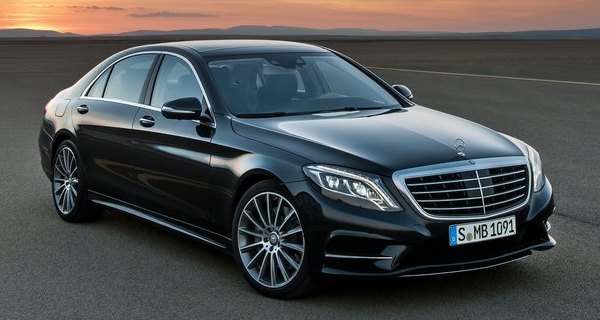 |
|
Its
exterior design combines the prominent, graceful radiator grille of
traditional Mercedes with a sleeker, sportier and more sculpted shape
that we have seen on CLA.
|
|
No
other cars could
dominate its class for so long. In the past 50 years, Mercedes S-class
has been the best selling large luxury car in the world. It is the
standard that every rival has to be judged against (and most failed to
match). Although more rivals emerged and got stronger in recent years,
the S-class has never lost its crown once. The outgoing generation,
W221 series, sold well in the past 8 years, with 515,000 units
delivered. This was the best sales performance since the legendary W126
(which still holds the record of 892.000 units in 12 long years). Even
near the end of its lifecycle it still registered 65,128 units of sales
last year, beating BMW 7-Series (59,184 units) and Audi A8 (35,932
units). However, to keep the top spot in the coming years it definitely
needs a bigger push. The new W222 series faces new challenges in a few
areas. Firstly, it needs to answer the call for green motoring,
reducing carbon footprint in a scale never seen before. Secondly, it
shall take on the increasing demand from China, whose buyers are
usually chauffeured thus strongly focus on back-seat comfort. Thirdly,
it has to stop its market share from stealing by new rivals as diverse
as Rolls-Royce Ghost / Bentley Flying Spur and Porsche Panamera /
Maserati Quattroporte. This mean it needs to be more luxurious and
sportier simultaneously. A very difficult task I would say.
Fortunately, the new S-class is very well designed and engineered. Its
exterior design combines the prominent, graceful radiator grille of
traditional Mercedes with a sleeker, sportier and more sculpted shape
that we have seen on CLA. Both headlights and taillights are made
entirely of LEDs and they contribute to the stylish lamp graphics. (By
the way, in addition to LED interior lighting, W222 is the first
production car in the world abandoning light bulbs completely.) The
exterior design also sets new class standard for aerodynamics – its
drag coefficient is lowered from 0.26 of the old car to merely 0.24 on
base models, or even as low as 0.23 for the sleekest S300 Bluetec
Hybrid model. That is way better than Audi A8 (0.26), Lexus LS (0.27)
and BMW 7-Series (0.28). In fact, it is just shy of the world record of
0.22 set by CLA180 BlueEfficiency Edition.
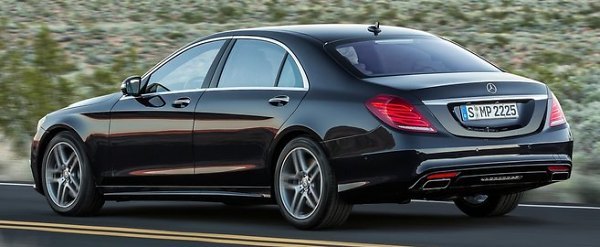 |
|
Drag
coefficient is merely 0.23 for the sleekest S300 Bluetec Hybrid.
|
|
The new
S-class keeps the same wheelbase as the old car, i.e. 3035 mm
and 3165 mm for standard car and LWB version respectively. It is 40 mm
longer overall, 28 mm wider and 23 mm taller. Track widths have
increased by 24 mm up front and 31 mm at the rear. While the
dimensions are not significantly different, the chassis is a different
story. Its front chassis is constructed entirely of aluminum alloy,
including the crash structure, side members, suspension tower brackets
and diagonal reinforcement beams. From firewall rearward the chassis is
constructed in steel – mostly hot-formed high-strength steel, as it
ensures the passenger cell to be more rigid than what aluminum can
achieve. Outside, all the skins are pressed aluminum sheets, including
the
bonnet, boot lid, fenders, door shells (as before) and now also the
roof panel.
Thanks to the new chassis construction, its torsional rigidity is
lifted significantly from 27500 to a class-leading 40500 Nm/degree. As
I know only Rolls-Royce Phantom (also 40500 Nm/degree) and a few
carbon-fiber supercars can match or exceed it. It goes without saying
that a rigid chassis benefits NVH suppression as well as handling and
ride. Simultaneously, the new car is able to undercut the old car
slightly on scale. For example, the new S500 is 15 kg lighter than
before at 1920 kg DIN, while S350 Bluetec is 40 kg lighter at 1880 kg.
You can see more weight saving measures from the diagram below.
Theoretically, these measures would have cut the kerb weight by 95 kg
if not the added luxury features offset most of the saving.
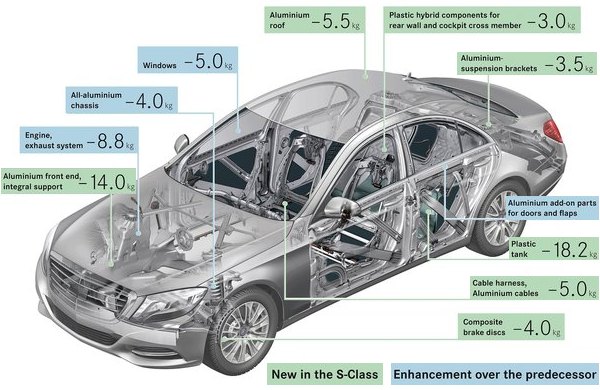 |
|
Aluminum-intensive
chassis would have cut the kerb weight by 95 kg if not the added
luxury features offset most of the saving.
|
|
The
all-aluminum suspensions are similar to the old car but
there are some refinements. Up front, the 4-link suspension still
consists of an upper wishbone, two lower individual links and a track
rod. At the back, the 5-link suspension is now mounted on an aluminum
subframe. The standard setup employs Airmatic adjustable air springs
with continuous adaptive damping like before, but it has been modified
to provide a softer ride on high-frequency small irregularities (read
better ride over pavements), while the spring travel has also been
increased to take on larger bumps.
On the road, the S-class is really refined. The chassis feels
rock-solid and very little road and wind noise can be heard inside. The
engine (at least the petrol V8) is whispering quiet. Overall refinement
seems to be on a par with Rolls-Royce Ghost. The standard Airmatic
suspension
offers exceptional ride comfort, more so than the old car.
Nevertheless, Mercedes is not content. It offers an even more advanced
suspension technology called "Magic Body Control". This combines the
existing Active Body Control – which uses adjustable hydraulic struts
to alter spring and damping rates on individual wheels – and a new
feature called Road Surface Scan. The latter employs a stereo camera
mounted near the rearview mirror to scan the road ahead (within 15
meters), detecting any bumps and adjusting the damping stiffness on
individual wheels in advance. For example, when the car is coming to a
speed bump, the camera detects its distance and size, calculates when
the encounter will occur and the compression of suspension needed, then
signals the hydraulic strut to compress with the right amount and at
the right moment, and similarly to release with the right amount and at
the right moment when the bump is getting over. This predictive
function takes the active suspension to a new era. The ABC is also
improved compared with the last generation. Now the spring strut gets
more responsive and the damping becomes continuously variable. Its data
processing power is also doubled.
With MBC equipped, the new S-class' ride is nothing short of magic. It
keeps the body control unflappable while filtering out larger bumps
that would have unsettled other luxury cars. The low-speed ride comfort
and composure is really amazing. There is room for improvement though.
At the moment the system doesn't work with higher speed, smaller bumps
or when the visibility is poor. I expect Mercedes will keep developing
it and expand its scope in the next generation.
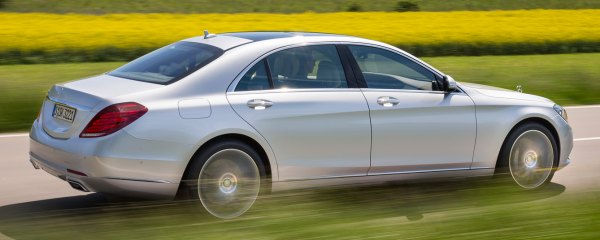 |
|
With
MBC equipped, the new S-class' ride is nothing short of magic.
|
|
Regarding handling, the S-class is also
remarkably easy to control for its size. While the term "agile" is
probably overstated, it is by no means as bulky as its size suggested.
The advanced suspension keeps its body well controlled. In Sport mode –
yes, it offers a Sport mode! – the car resists understeer and roll very
well, while the transmission and engine feel adequately swift. The
steering is nicely weighted, but there is an artificial feel in its
response, in particular the self-centering. There are a number of
autonomous driving aids that can intervene the electrical power
steering. Maybe they ruin the natural feel.
Following the traditional approach of Stuttgart, the new S-class has
its engines mostly carried over from the last generation (after all,
they were renewed just 2 years ago). Initially, there will be
4 models: S300 Bluetec Hybrid (2.2 turbo diesel + small electric
motor), S350 Bluetec (3.0 V6 turbo diesel), S400 Hybrid (3.5 V6
petrol + small electric motor) and S500 (4.7 twin-turbo V8). The only
notable mention is the V8 has its output pumped up by 20 hp to 455 hp.
This gives it a remarkable 0-60 mph time of 4.6 seconds. Next year, the
range will be added with S500 Plug-in
Hybrid, which will combine the new 333 hp 3.0 twin-turbo V6 with a 109
hp electric motor. Also certain to arrive at later dates are the S400,
S600, S63 AMG and S65 AMG.
Initially, all cars still relies on the long-serving 7-speed automatic,
although it has been renamed to 7G-Tronic Plus to represent a new
torque converter with reduced slip and an Eco mode with wider ratio
spread. However, starting from next year it will be replaced with the
new 9G-Tronic.
The S500's twin-turbo V8 matches the car very well. It is very smooth
and quiet, lag-free and torquey at any rev. It provides effortless
performance. Push harder on highway and it will produce a sonorous
soundtrack to delight your ears. Comparatively, Mercedes diesel engines
are less remarkable, sounding coarser and more reluctant to rev than
the best examples elsewhere. That said, their NVH is well insulated
from the cabin of S-class.
 |
|
The
build quality and luxury have been elevated to a whole different league.
|
|
The cabin is a
little bit larger than the old car's. Up front, there is
12 mm more headroom and 14 mm more shoulder room. At the rear, legroom
and shoulder room are stretched by 14 mm and 9 mm respectively.
However, what really revolutionized is the design and packaging. At the
first glance, it appeared rather odd to me, as it combines British
conservatism and high-tech gadgets. The former can be seen in its
Bentley-style dashboard and air vents. The design details, materials
and craftsmanship have been vastly upgraded to the extent that now the
S-class is a worthy alternative to the small Bentley and Rolls-Royce.
The high-tech theme is obvious in the full LCD instrument panel, which
inevitably looks out of place amongst the surrounding wood trim.
Unusually, Mercedes joins the main instrument and infotainment screens
together and houses them under the same huge, rectangular pod. Frankly,
its shape has little aethestic to speak of. But as soon as you press on
the start button, your attention will be drawn to the pair of huge,
12.3-inch TFT screens, amazed by their size and clarity.
Following the demise of Maybach, the S-class needs to take care of the
richest buyers who usually occupy the back seat. Therefore the W222 can
be optioned with countless of really cool features. One of
them is tycoon seats. Unlike typical German seats, they are made of
soft leather like British luxury. They can recline to wide angles and
offer leg rests for the boss to take a sleep. They are also heated and
cooled, and even provide hot-stone massaging! A pair of aluminum
folding tables can be unflipped from the rear center console like what
you see on
airliner. Want to relax before giving an important speech? There is a
24-speaker 3D surround sound system, active perfuming system and LED
ambient lighting that can be adjusted to 7 colors and 5 levels of
brightness. In terms of luxury features and interior finishing, the new
S-class is clearly a class above BMW 7-Series and Audi A8 etc. It moves
closer to the territory of Rolls-Royce and Bentley.
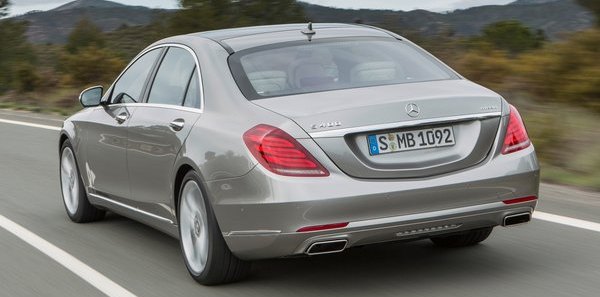 |
|
While
the term "agile" is probably overstated, it is by no means as bulky as
its size suggested.
|
|
And then there are more high-tech safety equipment and driving aids
than you can find on any other cars in the world. For example, it uses
two cameras and 3 different types of radar to scan the objects in
different range. Its computer vision can read the white lines on the
road and keep the car on track. It can detect human and animals in
front, brake or even steer the car to avoid collision. It can guide the
car through traffic, following the car in front at up to 37 mph. It can
foresee rear collision, tighten the seat belts and lock the brake to
reduce injury. This is the closest thing to the self-driving car that
Google is developing.
The weaknesses? Apart from the aforementioned artificial steering feel
and average diesel motors, the W222 is hard to fault. It is slightly
faster and better to drive than before, a lot more refined and
comfortable to travel in. The build quality and luxury have been
elevated to a whole different league. Moreover, it continues to lead
the world in technology. Not only this is still the best mass
production luxury car in the world, but now it feels truly special.
While the 7-Series is a supersized 5-Series and A8 is a luxury
interpretation of A6, the S-class feels totally irrelevant to the
E-class. It is a standalone development and undoubtedly more costly
than its rivals. From this view point, the slight price premium it asks
for is by no means unreasonable.
|
Verdict:      |
Published
on 25
Sep 2013
|
All rights reserved.
|
|
S63 AMG
|
|
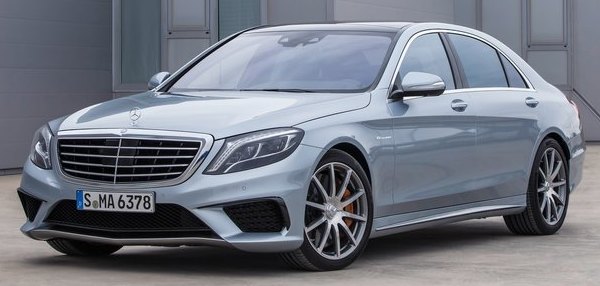 |
|
The
S63 is fast and luxurious, but never feels involving to drive.
|
|
The regular Mercedes S500
is already good for 0-60 mph in 4.6 seconds. In practical terms there
is really no need for a faster version. However, in the world of luxury
motoring there is always a strong desire to pursue for more – let it be
power, performance, luxury or technology – just to show that the new
car is superior to others. As long as the S-class exists, there will be
a faster AMG version to delight the very richest.
The latest S63 AMG is the first S-class AMG model integrated into the
S-class program from the beginning. Because of this, it does not need
to make heavy modifications, thus it can be launched just a couple of
months after the mass production model. Outside, the S63 is barely
subtly differed from the regular model by new bumpers and quad-exhaust.
It doesn't shout about performance as loud as lesser AMG models, but
that is exactly what the high-end customers would be pleased to see.
The new car is not only benefited from the donor car's
aluminum-intensive chassis and body, but it also introduces extra
weight saving measures. For example, the lead-acid starter and backup
batteries have been replaced with a lithium-ion battery to save 20 kg.
The spare wheel well at the boot has been converted from steel to
carbon-fiber to shave another 4 kg. The new forged alloy wheels and
composite (alloy-hub) brakes also cut weight. Overall, the new car is
75 kg lighter than the old car in rear-drive short-wheelbase form,
while LWB version is 100 kg lighter. Now both cars tip the scale just
under 2 tons. It might not sound remarkable, but remember, a Bentley
Flying Spur weighs some 2.4 tons!
More predictable is the twin-turbo 5.5-liter direct-injected V8. Its
specifications are close to that fitted to the recent E63 AMG S, with
the same maximum output of 585 horsepower delivered at 5500 rpm, but
peak torque has been boosted from 590 to 664 pound-foot to match the
outgoing S63. Also like its smaller brother, 4matic all-wheel-drive
system is available for the first time. It normally delivers two-third
of torque to the rear axle. Benefited with extra traction, its 0-60 mph
sprint is shortened to an eye-popping 3.9 seconds, which is incredible
for a car so big. The RWD version takes four-tenths longer to do 0-62
mph. Top speed is normally governed at 155 mph, but it is possible to
raise the speed limit to 186 mph. As before, AMG's 7-speed MCT gearbox
distinguishes it from the torque-converter automatic on lesser S-class
models.
Strangely, 4matic is only available on LWB model. Even stranger, the
RWD model and 4matic model employ different suspension technologies –
the former comes with the new S-class' Magic Body Control, which
combines the existing Active Body Control (variable hydraulic struts)
with road-scanning camera to provide an excellent ride. Instead, the
4matic model is mandatory with Airmatic air suspensions and ADS-plus
continuous adaptive damping, which is simpler and lighter. This
explains why the LWB 4matic model is only 25 kg heavier than the SWB
RWD model (remark: theoretically, the 4matic and LWB option should add
55 kg and 20 kg respectively). In the
suspension hardware, AMG has barely increased the negative camber and
rear anti-roll bar stiffness a bit. Regardless
of suspensions, all S63 offer a cosseting ride not far away from the
regular S-class. If you leave it in Comfort mode, you will find it the
smoothest and quietest car to ride in the world of high-performance
limousines.
Switch to Sport mode, the variable exhaust opens its flaps and you will
enjoy more the V8 burble and sonorous howl on full throttle. The torque
and performance it delivers is phenomenal. It has its mass overcome
with ease, punching from regular cruising speed to 150 mph in a matter
of seconds. Meanwhile, you feel safe and well insulated from the
outside world, thanks to the rigid construction and superb NVH
insulation. The S63 also corners with remarkable agility and composure
so that you will forget about its size. It grips well, resists roll and
understeer better than it has any right to be. The braking from the
huge ceramic discs is strong. High-speed stability is superb, as you
would expect for an Autobahn rocket. On dry tarmac, the RWD model shows
no signs of inferior grip, but it is not keen to power slide either –
its long wheelbase and compulsory stability control prevent it to do
so. The big AMG is by no means the last word of driver's car. In fact,
it never feels involving to drive, blame to that artificially-weighted
steering (like the regular S-class) as well as the general feeling of
isolated from the outside world. It goes without saying that you can't
have both the highest level of involvement and refinement. If you
prefer the former, you had better to get a Maserati Quattroporte or
Jaguar XJR. If you bias towards comfort, then nothing could quite match
the S63 AMG. Just make sure you have driven the S500 first.
|
Verdict:     |
Published
on 5
Oct 2014
|
All rights reserved.
|
|
S500 Plug-in Hybrid
|
|
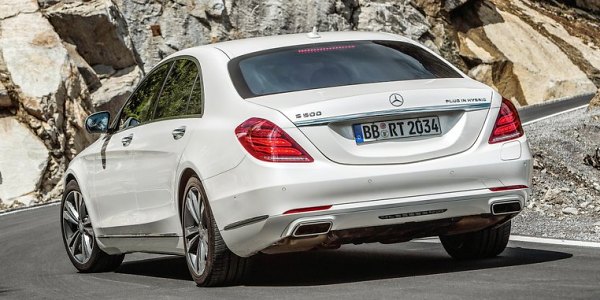
|
|
The
third incarnation of S-class hybrid is finally a plug-in.
|
|
This is the third hybrid
model of the S-class range. The last two, S300 Bluetec Hybrid and S400
Hybrid, were actually stop-gap models based on outdated mild hybrid
technology. The new one, as its name suggested, is not only a full
hybrid but also a plug-in hybrid. It can be recharged at home socket
for less than 3 hours, and then propel the car with battery power alone
for up to 33 km (20 miles). The electric motor is again integrated into
the housing of 7G-Tronic transmission for ease of installation. It is
good for 116 horsepower, compare to merely 27 hp on the mild hybrids,
and a maximum torque of 251 lbft. This allows the EV mode to work up to
87 mph. When battery runs low, the petrol engine joins. It is a stock
M276 3.0-liter twin-turbo V6 as used on many Mercedes "400" models,
rated at 333 hp and 354 lbft. Combined maximum output is 442 hp and 479
lbft, high enough for Mercedes to use the "S500" badge. All out, 0-60
mph can be achieved in 5 seconds flat, while the regulated top speed of
155 mph is achieved with petrol engine alone.
The 8.7 kWh lithium battery pack is located right above the rear axle
thus it creates a step in the boot and reduces luggage capacity from
510 to 395 liters. The on-board charger and conventional 12V battery
are also placed under the boot. Theoretically, this should improve
weight distribution, but considering the car weighs some 2140 kg, it is
not going to be a sports sedan anyway. The hybrid integration is
seamless. You can hardly detect the transition between power sources,
except that the EV mode running is even quieter than the standard
S-class. On EU combined cycle, the S500 Plug-in Hybrid is good for 101
mpg and emits only 65 grams of CO2 each
kilometer. Although we all know
it is impossible to replicate these figures in real-world driving, it
is undoubtedly a lot greener than the V8-powered S500.
|
Verdict:      |
Published
on 26
Jan 2015
|
All rights reserved.
|
|
Mercedes-Maybach S600
|
|
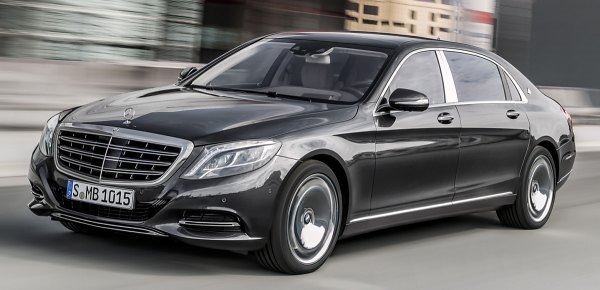
|
|
Not
just a name change, the Mercedes-Maybach S-class could be a game
changer in a class previously reserved for Bentley and Rolls-Royce.
|
|
Up until now there aren’t
many choices for the daily transport of billionaires. Basically, they
are limited to two British marques, Rolls-Royce and Bentley. Although
German premium marques have been dominating the mass production luxury
class for long, they are considered not exclusive enough to earn the
favour of super-rich. A dozen years ago, Mercedes attempted to break
the British domination with Maybach, a heavyweight, lavishly equipped
and conservatively styled Bentley/Rolls-Royce beater. Somehow, it
turned out to be a commercial failure, with only 3200 sales recorded in
its 10-years lifespan, then the division was closed. A lesson was
learned: you need heritage to succeed in this class. That’s also why
BMW and Volkswagen had to acquire the British marques.
However, there is more than one way to succeed. If it is not possible
to fight with the British marques head-on, why not take a different
route? Mercedes has the best mass production luxury car in the world,
the widely acclaimed W222 S-class. Why not simply upgrade it to a
“super S-class” with more space and luxury features? This would be far
more cost effective than the late Maybach, yet the car can be
benefitted from the superior driving dynamics, safety and luxury
technology of the S-class. It could be priced at
£165,000, much lower than the
£200,000 of
Rolls-Royce Ghost or £230,000 of Bentley
Mulsanne, so it should achieve higher sales volume. The only question
is how to name the car to reflect its superior status. How about
Mercedes-Maybach S-class?
The Mercedes-Maybach S-class does not hide its relationship with the
S-class. It is marketed as an extension of the S-class rather than a
standalone line. It can be available in various models depending on
engines, like S500 or S600. By the way, in the future the Maybach
treatment may be applicable to E-class and other lines, too, so it will
represent the luxury facet of Mercedes in the same way as AMG
representing the sporting side.
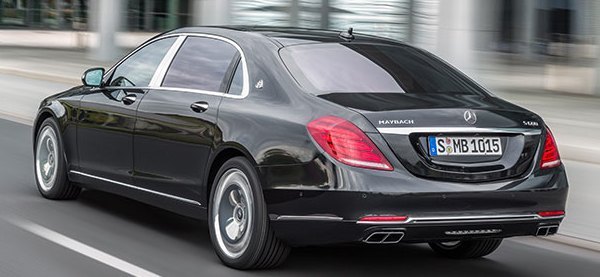
|
|
The
wheelbase is 200 mm longer than even the long-wheelbase version S-class.
|
|
Viewing from the front, the Maybach is indistinguishable from other
S-class models. It differs only from the B-pillars rearward. The
B-pillars are now chromed instead of black to appear classier. The rear
side windows are stretched, while the reshaped rear quarter windows
have lost the fast angle of the standard car. Note that those quarter
windows are now fixed to the body and separated from the doors. This
allows thicker seals to be used thus improves sound insulation.
Besides, you can find a Maybach logo at each C-pillar.
The wheelbase of Maybach is stretched to 3365 mm, 200 mm longer than
even the long-wheelbase version S-class. This liberates 159 mm more
legroom for the boss sitting at the back. It also gives him/her 12 mm
extra headroom. Predictably, Mercedes applied extra reinforcement to
the chassis and more sound insulation throughout the cabin. The car
tips the scale at 2260 kg, 150 kg more than the equivalent S-class.
That is still 100 kg less than RR Ghost and 325 kg lighter than Bentley
Mulsanne.
The cabin shares the same high-tech TFT dashboard with lesser S-class.
Like S-class Coupe, you can have bespoke wood and stitched leather trim
covering the dash and door panels. It appears classy, if lacking the
handcrafted feel of its British rivals. However, its modern and
high-tech theme is a sharp contrast to the traditional approach of
Rolls-Royce and Bentley. Younger customers should prefer it. Needless
to say, the rear passengers are served with enormous space and endless
comfort. The standard car is fitted with bench seats, but many will
choose the optional first-class airliner seats. They can recline to
43.5 degrees and provide a calf support for the boss to take a sleep.
They are heated and cooled and may even offer hot-stone massaging. The
rear center console is the home of infotainment and climate control, a
pair of folding tables, heated/cooled cup holders and refrigerator. The
climate control blows ionized air, and the powerful 24-speaker audio
system produces wonderful 3D surround sound. Look up the sky, you will
see the Magic Sky Control panoramic roof, whose translucent level can
be altered. So it trades classic flavours for modernity.
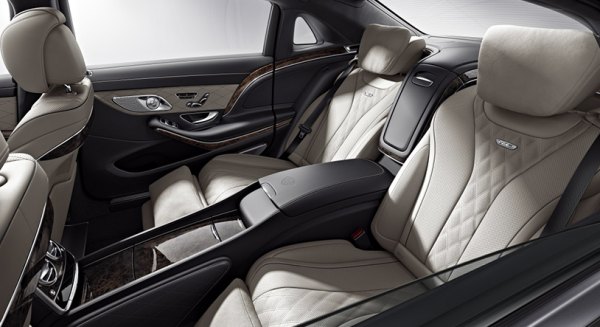
|
|
First-class
airliner seats is a must-have option.
|
|
Mercedes claims this is the quietest cabin in any production cars. I
wonder if the claim has taken Rolls-Royce Phantom into account, but on
the road it is at least a match to Ghost and quieter than any Bentleys.
A similar story can be told for its ride quality. Mercedes’ Magic Body
Control might not be as soft as Rolls-Royce in any road conditions, but
it controls the body movement far more satisfyingly. This means it
feels just marginally bulkier to steer than the regular S-class. For a
big limousine it is amazingly athletic. The S600’s twin-turbo V12 is
strong yet silky smooth and whispering quiet. 530 horsepower is
sufficient to register 0-60 mph in under 5 seconds. Overall, the car
has no weakness.
Ultimately, some super-rich insist to have a more exclusive car than
one based on the mass production S-class. Some prefer the conservative
design and traditional craftsmanship offered by the British marques.
Some simply won't consider the Mercedes-Maybach S-class because it is
not the most expensive. Forget these people. When Mercedes decided to
realign the Maybach brand, it had accepted to abandon the previous
target customers and look for wider audiences. Think about it, to sell
2,000 bespoke Rolls-Royce Ghosts a year at £200,000 apiece or
4,000 S-class-based-Maybachs at £165,000 apiece, which one is
more profitable? Sometimes to be the second-best is the best business
strategy.
|
Verdict:      |
Published
on 5
Aug 2017
|
All rights reserved.
|
|
S-class facelift 2017 and new straight-6
|
|
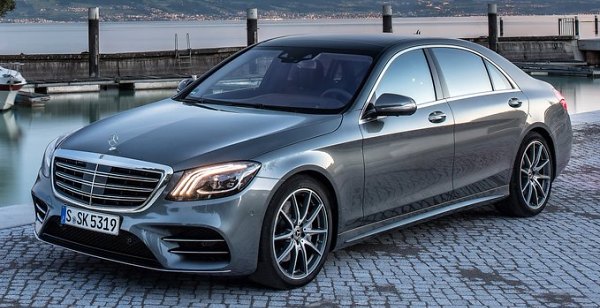
|
|
The
focus of this facelift is not cosmetic, but the new generation engines.
|
|
The W222 S-class has spent
the past 4 years on the top of the luxury limousine segment yet without
any signs of fatigue. However, it is receiving a mid-life facelift and,
following the practices of Mercedes facelifts, introducing a new range
of engines, so to make sure its leading position will last
through it entire life. Even without counting the new engines, there
are 6500 new components introduced, so it is probably the most
comprehensive facelift the S-class has ever received.
Outside, there are some refinement to the front bumper profile and
intakes as well as new graphics on the LED headlights. Inside, the
trims and quality of materials have been improved slightly. As for
electronic driving aids, it shares the semi-autonomous driving
technology of the new E-class. This means the car will cruise
automatically up to 130 mph, reading the roads ahead, lane markings,
fences and cars surrounding to keep it on track, reading road signs to
avoid speeding. More so than that of the E-class, the system has
learned to slow down at junctions and roundabouts. The car will slip
into tight parking space automatically, too. The only thing it won’t do
is fully self-driving on the road, as you will need to keep your hands
on the steering wheel. The new Audi A8 is slightly
more advanced in this respect, as it is capable of full autonomous
driving during traffic jam at speeds under 37 mph. That said, I suppose
the Mercedes system will learn that soon.
Changes to the chassis is modest. It keeps the Airmatic air suspension
without adopting the E-class' more advanced 3-chamber version. Magic
Body Control with Road Surface Scan is still available as option for V8
models. The only change is that it has added the curve tilting function
of S-class Coupe, which tilts the body to the opposite side during
cornering to counter the g-force.
However, to car enthusiasts, the most
interesting is definitely the
return of straight-6 engines, a configuration Mercedes has abandoned
for
nearly 20 years. Straight-6 has always been a near-perfect
configuration for smoothness, sound and efficiency, no wonder Mercedes
has a long and glorious history of using straight-6. It might be
slightly more difficult to be packaged than a V6, but there is always
plenty of engine space in the company's rear-drive models (even
C-class). The reason why Mercedes switched to V6 in the late 1990s was
more
about production costs - V6 and V8 can be combined into the same
modular family and built on the same assembly line. The resultant V6 is
compromised, of course, as it followed the V8 to adopt 90-degree
angle, which needed the addition of a balancer shaft to cancel
vibration. Now the world has changed. The trend of downsizing put more
emphasis on 3 and 4 cylinders, so Mercedes found grouping the
6-cylinder engine into its next generation 3 and 4-cylinder engines as
a modular family will make more
business sense, i.e. a viewpoint shared with BMW. This leads to the
return of both petrol and diesel straight-six.
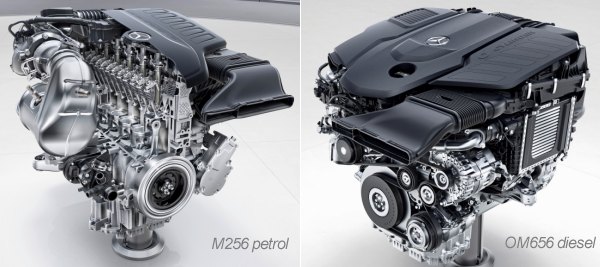
|
|
Mercedes
finally surrects its good old straight-six!
|
|
The new M256 petrol straight-6 displaces 2987cc. Its combustion
chambers are undersquared, with 83mm bore and 92mm stroke, so the
engine is not as long as imagined. Moreover, it uses an integrated
starter generator (ISG) attached directly to the crankshaft, getting
rid of belt drive thus reduces the engine length further. The
turbocharger and catalytic converter are mounted just
beside the engine, ditto an electric charger. Yes, Mercedes follows
Audi to be the world's second car maker to use electric
charger. It
spins to 70,000 rpm in just 0.3 second, vastly improving the engine's
low-end response. Again like Audi, the electric charger necessitates a
more powerful 48V electrical system, so the M256 has a 1kWh lithium
battery supplying 48Vdc (it keeps a conventional 12V battery, but has
it downsized). It is also used to supply the water pump, air-con and
ISG. The ISG can supply up to 22 hp and 184 lbft of torque on short
burst to aid acceleration. In other words, it is a mild-hybrid system.
With ISG and electric charger to take care of low-end response, the
M256 can use a larger exhaust gas turbo to enhance power at higher revs
without
worrying of turbo lag. The result is a remarkable 435 horsepower
released at 5900 to 6100 rpm, and 383 pound-foot of peak torque is
available from 1800 to 5500 rpm. Those are the figures for the new
S500, a nameplate traditionally reserved for V8, mind you. A detuned
version powering S450 offers 367 hp and 369 lbft.
Admittedly, the new straight-six S500 is down on power and especially
torque compared with the old, 4.7-liter V8 model wearing the same
badge. However, its responsive manner and the combination of 9G-Tronic
(replacing 7G-Tronic) transmission is able to offset the loss of power,
resulting in an identical 0-60 mph time of 4.6 seconds.
When it comes to fuel consumption, it undercuts the V8 by 22 percent.
Most
important, you won't feel any loss of grace in the downsizing because
the straight-six feels creamy smooth, hushed yet musical if you really
listen to it. Congratulation to the return of a great engine!
Meanwhile, the new OM656 diesel engine is also a straight-6. It
displaces 2925 c.c., employs aluminum block and head but special
stepped-bowl pistons made of steel to improve combustion efficiency.
The
addition of Camtronic variable exhaust valve lift is believed to help
emission, while Nanoslide
coating on bores
reduces friction. Two-stage turbocharging guarantees quick response and
high output. On S400d, the engine produces a remarkable 340 hp and 516
lbft of torque, way more than the old diesel V6 (only 258 hp), even
eclipsing its BMW and Audi rivals. On the lesser S350d, it produces 286
hp and 442 lbft. Both engines are remarkably smooth and quiet from idle
to redline. In fact, in normal driving you are hard pressed to tell if
it is a diesel.
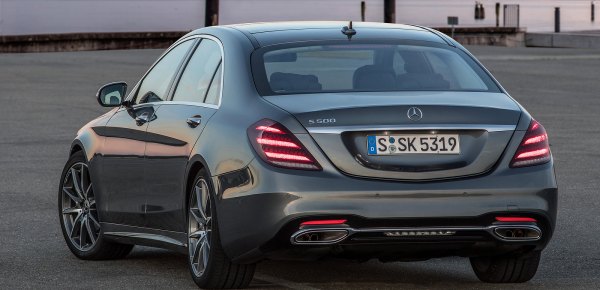
|
|
These
might be the last generation engines in automotive history...
|
|
V8 still lives on the S-class, but it is downsized as well. Having lost
the cost sharing with V6, the new Mercedes production V8 is merged with
AMG's 4.0-liter unit, although it gets milder tuning and a
different codename, M176. On the new S560 - a nameplate ressurrected
from the ultimate S-class in the late 1980s - the V8 delivers 469 hp,
14 more than its 4.7-liter predecessor, and the same 516 lbft of
torque. Downsizing and the use of cylinder deactivation technology
allows it to cut 10 percent fuel consumption. Disappointingly though,
the S560 is just a tenth quicker than the six-cylinder S500 to 60 mph.
Its advantage is mainly psychological, as many people still think a
luxury car should be powered by V8.
Sitting atop the S560 is the V12-powered S600 and Maybach S650. The
former is unchanged at 530hp, while the latter is upgraded to the
S65-spec. with 630hp. The AMG S65 is unchanged, as it is always a slow
seller.
Meanwhile, S63 switches to the new 4-liter V8 like all other AMG '63
models. It produces 612 hp, the same as E63 S, but torque is silently
lifted to 664 lbft to match
its 5.5-liter predecessor. This means it is the most powerful version
of the AMG 4-liter V8 at the moment. It is also the only member of the
S-class
employing the 9-speed MCT gearbox and 4matic+ rear-biased,
variable-split 4WD system, both come from the E63. The new car takes
only 3.4 seconds to go from rest to 60 mph, so much faster than the old
car!
A couple of days ago, automotive component giant Continental predicted
German car makers to stop developing new engines from 2023 as they are
switching to electric propulsion. A few countries have already
announced plans to ban petrol and diesel cars: Britain and France from
2040, Norway from 2025, while Sweden and Germany's federal council are
pursuing to do the same from 2030. It seems the days of good old
engines are numbered. If I were the head of Mercedes powertrain
development, I would probably keep updating the existing straight-sixes
and V8s until the extinction of combustion engines rather than
developing another generation of new engines. This means, what you see
here is probably the last generation of a technology that car lovers
talked and enjoyed so much in the past 130 years, sadly.
By then, I think AutoZine will go together with engines, because
electric motors are too boring to write about.
|
Verdict:      |
|